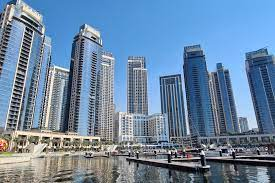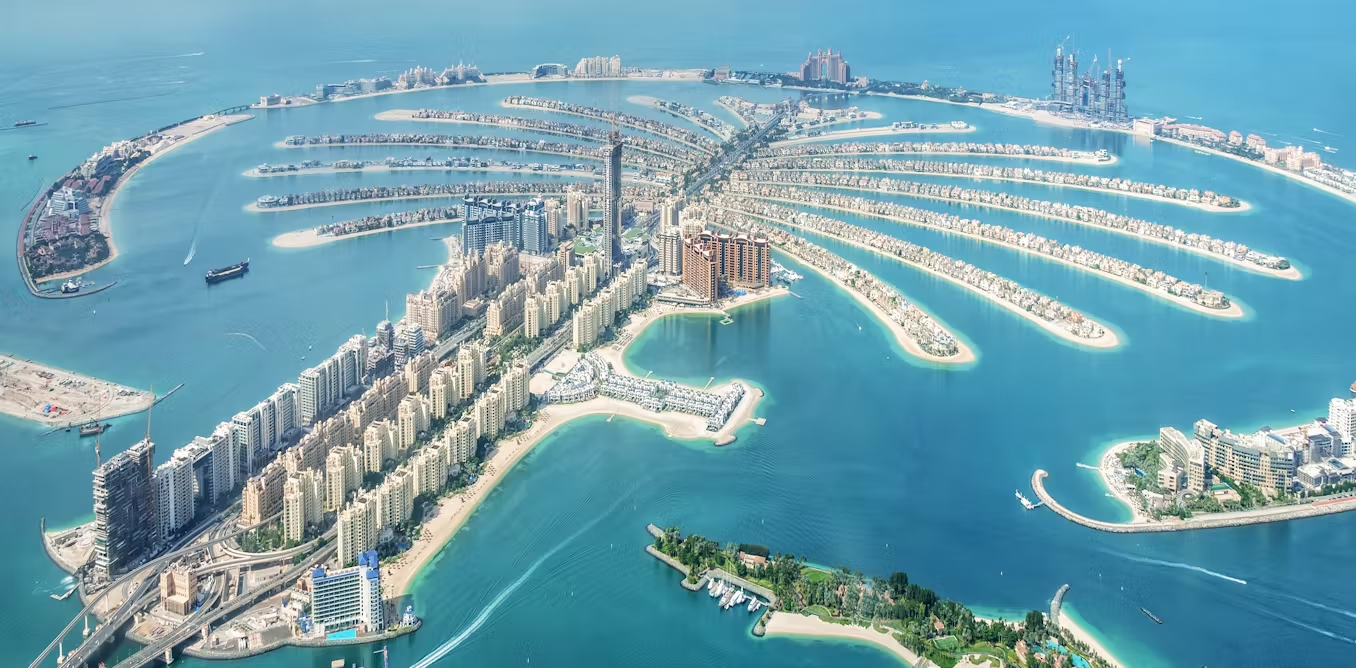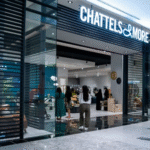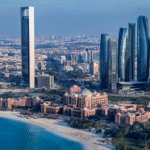Now Reading: Luxury vs Affordable: Dubai’s Real Estate Options Across Cities
-
01
Luxury vs Affordable: Dubai’s Real Estate Options Across Cities
Luxury vs Affordable: Dubai’s Real Estate Options Across Cities
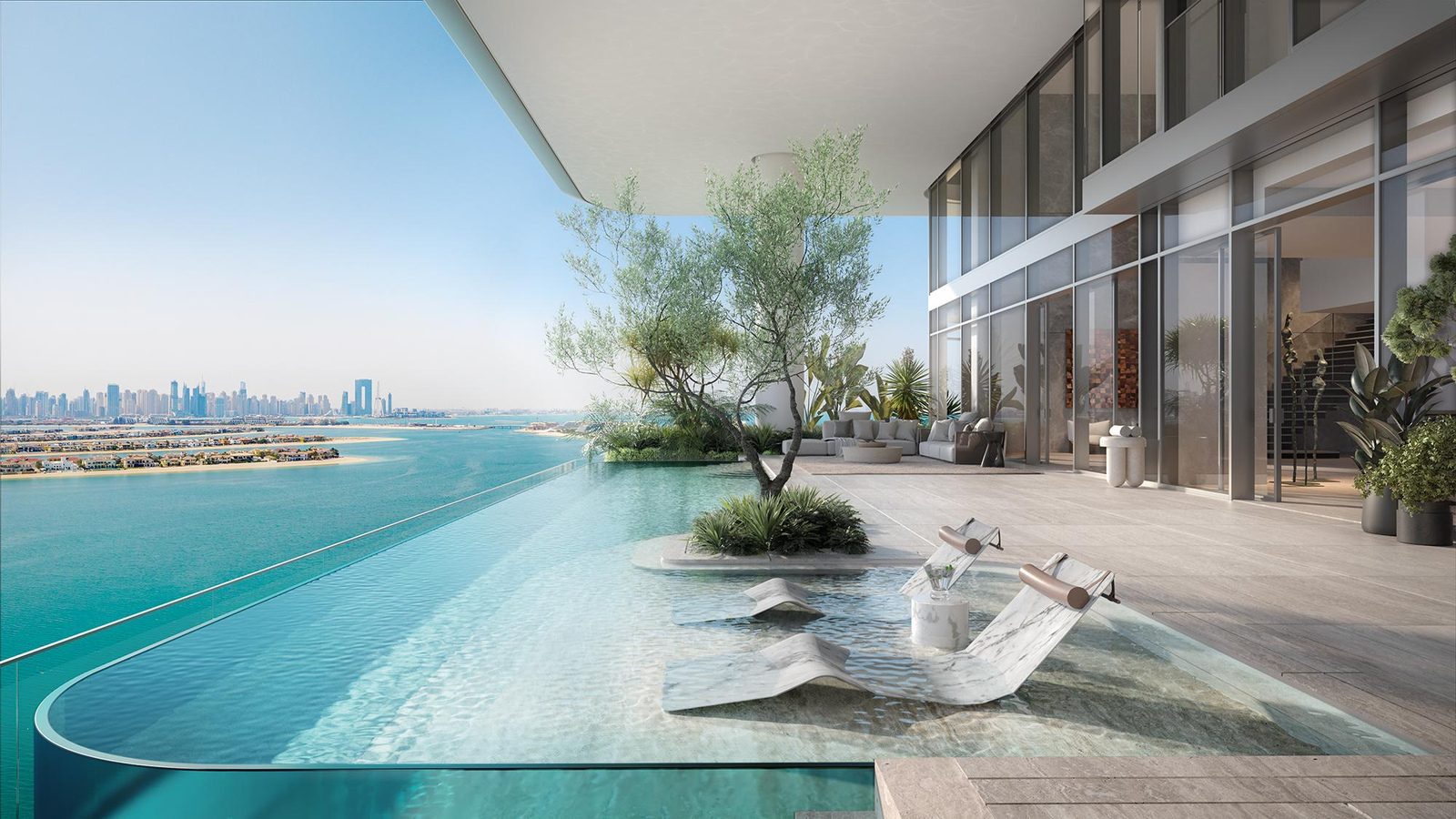
Table of Contents
Picture yourself in Dubai, where your home could be a glittering penthouse overlooking the Burj Khalifa or a cozy apartment near bustling community parks, each promising wealth and a vibrant lifestyle. In 2025, Dubai’s real estate market is thriving, with 96,000 transactions worth $87 billion in the first half, 58% driven by buyers from the UK, India, Russia, and China. Offering 100% freehold ownership, a dirham pegged to the U.S. dollar, and no personal income tax, capital gains tax, or annual property taxes, Dubai delivers 6-10% rental yields and 5-15% price appreciation, outpacing London (2-4%) and New York (2-3%).
Properties over $545,000 qualify for a 10-year Golden Visa, while smaller units offer 2-year residency. Fueled by 25 million tourists and a 4% population surge, the city’s luxury and affordable options cater to diverse investors. This guide compares luxury projects like Burj Al Arab Views (Downtown Dubai) and Atlantis The Royal Residences (Palm Jumeirah) with affordable gems like Binghatti Heights (JVC), Al Furjan West (Al Furjan), and Dubai South Residences (Dubai South) to help you choose your perfect investment.
Why Dubai’s Real Estate Appeals to All
Spanning 15-40 minutes from Dubai International Airport via Sheikh Zayed Road or metro, these areas offer villas, apartments, and penthouses with vacancy rates at a low 2-3% compared to 7-10% globally. You keep 100% of rental income $24,000-$240,000 annually on a $400,000-$4 million property versus $13,200-$144,000 elsewhere after taxes.
Zero capital gains tax saves $30,000-$280,000 on a $150,000-$1 million profit, and no annual property taxes save $4,000-$80,000 yearly, unlike London’s council tax (up to 2%) or New York’s property tax (1-2%). Residential purchases dodge 5% VAT ($20,000-$200,000), and Golden Visa perks enhance residency appeal. Luxury areas like Downtown and Palm Jumeirah offer prestige and high growth, while affordable hubs like JVC, Al Furjan, and Dubai South provide value and accessibility.
Investing in Dubai feels like choosing your own path to prosperity.
No Personal Income Tax: Rentals for Every Budget
Both luxury and affordable areas impose no personal income tax, letting you pocket every dirham of rental income, unlike the U.S. (up to 37%) or UK (up to 45%). A $400,000 JVC apartment yielding $24,000-$36,000 saves $8,880-$16,200, while a $4 million Palm Jumeirah villa yielding $160,000-$240,000 saves $72,000-$96,000. Short-term rentals in luxury areas, boosted by 25 million tourists, require a DTCM license ($408-$816), increasing yields by 10-20% ($2,400-$48,000). Long-term leases in affordable areas like Al Furjan need Ejari registration ($54-$136) for stability. Non-compliance risks fines up to $13,612, so proper licensing is key.
Tax-free rentals feel like a gift that keeps giving.
Zero Capital Gains Tax: Profit Across Price Points
All areas offer zero capital gains tax, letting you keep 100% of sale profits. Selling a $400,000 JVC apartment for $500,000 after 25% appreciation yields a $100,000 tax-free profit, saving $20,000-$28,000 compared to London (20-28%) or New York (20-37%).
A $4 million Downtown penthouse sold for $5 million yields a $1 million tax-free gain, saving $200,000-$280,000. Price growth varies: Downtown and Palm Jumeirah hit 10-15% annually, JVC and Al Furjan 6-9%, and Dubai South 8-10%. A 4% Dubai Land Department (DLD) fee applies on resale ($16,000-$160,000), often split, but tax-free profits boost returns.
Keeping every dirham feels like a financial high-five.
No Annual Property Taxes: Save on Ownership
Unlike global markets where annual property taxes cost $4,000-$80,000 on a $400,000-$4 million property, these areas have none, easing ownership costs. Maintenance fees vary: $15,000-$25,000 for Downtown and Palm Jumeirah, $5,000-$10,000 for JVC and Al Furjan, and $8,000-$12,000 for Dubai South. A 5% municipality fee on rentals ($1,200-$12,000) applies, higher in luxury areas due to premium amenities. These costs are lower than London’s council tax ($8,000-$80,000) or New York’s property tax, making ownership affordable across budgets.
No property taxes feel like a warm welcome to your investment.
VAT Rules: A Buyer’s Advantage
Residential purchases skip 5% VAT, saving $20,000-$200,000 on a $400,000-$4 million property, unlike commercial properties or the UK’s stamp duty (up to 12%, or $48,000-$480,000). Off-plan purchases, common in JVC, Al Furjan, and Dubai South, may incur 5% VAT on developer fees ($5,000-$80,000), recoverable via Federal Tax Authority (FTA) registration ($500-$1,000).
Short-term rental operators in Downtown and Palm Jumeirah must register for VAT if revenue exceeds $102,041, charging 5% but claiming credits on expenses like DTCM fees ($408-$816). A $400,000 JVC apartment yielding $24,000-$36,000 incurs $1,200-$1,800 in VAT but allows $500-$1,000 in credits. Non-compliance risks fines up to $13,612, so record-keeping is essential.
VAT exemptions feel like a friendly nudge for your budget.
DLD Fees and Title Deeds: Securing Your Dream
The 4% DLD fee, typically split, is a key cost: $16,000 for a $400,000 JVC apartment or $160,000 for a $4 million Downtown penthouse. Gift transfers to family or shareholders reduce DLD to 0.125%, saving $15,500-$155,000. For example, gifting a $4 million property cuts the DLD fee from $160,000 to $5,000. Title deed issuance costs $136-$272 and must be registered with the DLD.
Broker fees, typically 2% ($8,000-$80,000), may be waived for off-plan projects in JVC or Dubai South. Mortgage registration (0.25% of the loan, or $1,000-$10,000) and valuation fees ($680-$1,360) apply for financed deals. The 2025 Oqood system ensures escrow compliance for off-plan purchases, protecting your funds.
Title deeds feel like the key to your Dubai journey.
Corporate Tax: A Note for Business Buyers
The 9% corporate tax, introduced in 2023, applies to businesses with profits over $102,110. A company leasing a $400,000 JVC apartment yielding $24,000-$36,000 faces a 9% tax ($2,160-$3,240), reducing net income to $21,840-$32,760. A $4 million Downtown penthouse yielding $160,000-$240,000 incurs $14,400-$21,600 in tax.
Qualified Free Zone Person (QFZP) status in areas like Dubai Multi Commodities Centre (DMCC) avoids this, saving $6,120-$61,200, with setup costs of $2,000-$5,000. Small business relief waives corporate tax for revenues under $816,000 until December 31, 2026. Individual ownership skips this tax entirely, ideal for most buyers.
Corporate tax feels like a speed bump you can navigate.
New Tax Rules for 2025
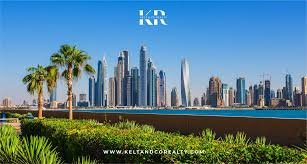
The Domestic Minimum Top-up Tax (DMTT), effective January 1, 2025, imposes a 15% tax on multinationals with revenues over €750 million ($793 million). Individual investors and smaller entities are unaffected, and QFZP status avoids DMTT, saving $6,120-$61,200. Cabinet Decision No. 34 refines Qualifying Investment Fund (QIF) rules, exempting corporate tax if real estate income is below 10%. A QIF earning $1 million, with $200,000 from rentals, faces 9% tax ($14,400) on 80% ($160,000). A July 2025 policy allows corporate tax deductions on fair market value depreciation, saving $6,545-$9,000 annually for a $3 million property revalued at $3.75 million.
New rules feel like a puzzle with profitable solutions.
Luxury Real Estate Options
1. Downtown Dubai: Burj Al Arab Views
Burj Al Arab Views by Emaar ($2 million-$4 million) offers luxury apartments with 5-7% rental yields and 10-15% price growth, driven by Burj Khalifa and Dubai Mall proximity. A $2 million apartment yields $80,000-$120,000 tax-free, saving $36,000-$48,000. Selling for $2.5 million yields a $500,000 tax-free profit, saving $100,000-$140,000.
No property taxes save $20,000-$40,000, and VAT exemption saves $100,000. Maintenance fees are $15,000-$25,000, with a 5% municipality fee ($4,000-$6,000). QFZP saves $20,400-$30,600. U.S. investors deduct depreciation ($36,364-$72,727), saving up to $24,545. Golden Visa eligibility and 25 million tourists boost short-term rental demand.
Downtown feels like owning a piece of Dubai’s iconic skyline.
2. Palm Jumeirah: Atlantis The Royal Residences
Atlantis The Royal Residences ($2.5 million-$10 million) offer ultra-luxury villas and apartments with 6-8% yields and 10-15% price growth, fueled by beachfront exclusivity. A $2.5 million apartment yields $80,000-$120,000 tax-free, saving $36,000-$48,000. Selling for $3.1 million yields a $600,000 tax-free profit, saving $120,000-$168,000. No property taxes save $25,000-$50,000, and VAT exemption saves $125,000. Maintenance fees are $15,000-$25,000, with a 5% municipality fee ($4,000-$6,000). QFZP saves $20,400-$36,000. U.S. investors deduct depreciation ($45,454-$90,909), saving up to $31,818. Golden Visa eligibility drives high-net-worth demand.
Palm Jumeirah feels like a lavish coastal escape.
Affordable Real Estate Options
3. Jumeirah Village Circle (JVC): Binghatti Heights
Binghatti Heights ($400,000-$800,000) offers 1-2 bedroom apartments with 7-10% rental yields and 6-9% price growth, driven by affordability and Circle Mall proximity. A $400,000 apartment yields $24,000-$36,000 tax-free, saving $8,880-$16,200. Selling for $500,000 yields a $100,000 tax-free profit, saving $20,000-$28,000. No property taxes save $4,000-$8,000, and VAT exemption saves $20,000. Maintenance fees are $5,000-$10,000, with a 5% municipality fee ($1,200-$1,800). QFZP saves $6,120-$12,240. U.S. investors deduct depreciation ($7,273-$14,545), saving up to $5,091. Golden Visa eligibility for properties over $545,000 appeals to budget buyers.
JVC feels like an affordable stepping stone to wealth.
4. Al Furjan: Al Furjan West
Al Furjan West by Nakheel ($500,000-$1 million) offers apartments and townhouses with 6-9% yields and 6-9% price growth, near Al Furjan Metro and Arbor School. A $500,000 apartment yields $30,000-$45,000 tax-free, saving $13,500-$20,250. Selling for $625,000 yields a $125,000 tax-free profit, saving $25,000-$35,000. No property taxes save $5,000-$10,000, and VAT exemption saves $25,000. Maintenance fees are $5,000-$10,000, with a 5% municipality fee ($1,500-$2,250). QFZP saves $12,240-$19,440. U.S. investors deduct depreciation ($9,091-$18,182), saving up to $6,364. Golden Visa eligibility boosts value.
Al Furjan feels like a vibrant, budget-friendly community.
5. Dubai South: Dubai South Residences
Dubai South Residences ($500,000-$900,000) offer apartments with 7-10% yields and 8-10% price growth, driven by Al Maktoum Airport and Expo 2020 infrastructure. A $500,000 apartment yields $30,000-$45,000 tax-free, saving $13,500-$20,250. Selling for $625,000 yields a $125,000 tax-free profit, saving $25,000-$35,000. No property taxes save $5,000-$9,000, and VAT exemption saves $25,000. Maintenance fees are $8,000-$12,000, with a 5% municipality fee ($1,500-$2,250). QFZP saves $12,240-$19,440. U.S. investors deduct depreciation ($9,091-$16,364), saving up to $5,727. Golden Visa eligibility and future metro plans drive growth.
Dubai South feels like a future-proof affordable hub.
Comparing Luxury vs Affordable Options
Price Range: Luxury (Downtown, Palm Jumeirah: $2 million-$10 million) suits high-net-worth investors; affordable (JVC, Al Furjan, Dubai South: $400,000-$1 million) fits first-time buyers.
Rental Yields: Affordable areas (7-10%) outshine luxury (5-8%), but luxury’s short-term rentals yield 10-20% more ($8,000-$48,000).
Price Appreciation: Luxury (10-15%) leads over affordable (6-10%) due to prestige and tourism.
Lifestyle: Downtown and Palm Jumeirah offer iconic, tourist-driven luxury; JVC, Al Furjan, and Dubai South provide community-focused affordability.
Amenities: Luxury areas boast premium malls and beaches; affordable areas offer parks, schools, and metro access.
ROI Verdict: Affordable areas lead with 8-12% ROI for budget buyers; luxury areas deliver 7-10% for prestige and growth.
Choosing feels like picking your perfect Dubai lifestyle.
Strategies to Maximize Returns
For individuals: First, hold properties personally to avoid corporate taxes, saving $6,120-$61,200. Second, negotiate DLD fee splits, saving $8,000-$80,000. Third, use gift transfers to reduce DLD to 0.125%, saving $15,500-$155,000. Fourth, recover 5% VAT on developer fees via FTA registration ($500-$1,000). Fifth, leverage double taxation treaties with 130+ countries, saving $8,880-$96,000.
Sixth, U.S. investors deduct depreciation ($7,273-$90,909), saving up to $31,818. For corporates: Secure QFZP status, keep QIF income below 10%, and claim depreciation deductions. Hire property managers ($5,000-$25,000 annually) and tax professionals ($1,000-$3,000) to avoid fines up to $136,125. Focus on short-term rentals in luxury areas and long-term leases in affordable ones.
These strategies feel like a roadmap to your wealth.
Risks to Watch in 2025
A projected oversupply of 182,000 units by 2026 may slow price growth, though demand mitigates this. Choose trusted developers like Emaar, Nakheel, or Binghatti and verify escrow compliance via the 2025 Oqood system. Non-compliance with VAT or DTCM rules risks fines up to $13,612, and corporate tax errors can cost $136,125. Indian investors must disclose properties in India’s Foreign Asset schedule to avoid $135,000 penalties. Currency fluctuations, like a 5% dirham shift, could impact returns.
Luxury or Affordable: Where to Invest?
Luxury Buyers: Choose Downtown or Palm Jumeirah for 7-10% ROI, 10-15% growth, and iconic lifestyles. Burj Al Arab Views and Atlantis The Royal Residences offer prestige and tourist-driven rentals.
Affordable Buyers: Opt for JVC, Al Furjan, or Dubai South for 8-12% ROI, 6-10% growth, and budget-friendly entry.
Binghatti Heights, Al Furjan West, and Dubai South Residences suit first-time investors.
Balanced Investors: JVC and Al Furjan offer affordability with metro access; Dubai South adds future growth; Downtown and Palm Jumeirah provide luxury with high appreciation.
With 6-10% yields, tax-free savings of $4,000-$280,000 annually, and Golden Visa perks, Dubai’s
and affordable options cater to all. Navigate fees, choose your project, and secure your wealth in Dubai’s thriving market.
read more: Dubai Creek Harbour vs Dubai Hills: Where to Invest Now?



